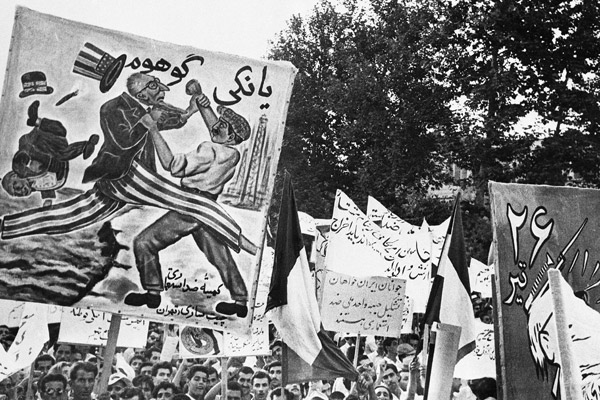‘What is your idea about Iran?’ friendly Iranians are heard to ask the few foreign visitors who still come their way. One is never quite sure whether by ‘idea’ they mean ‘impression’, ‘opinion’ or ‘theory’. Inspiring landscapes, fine cuisine and a tradition of hospitality make the first category easy ground. The second pertains to politics, and may lead the traveller into the most illuminating, entertaining and disturbing conversations he has ever had. The third, be warned, is dragon country.
British theories are infamous. A 1951 Foreign Office document identified Iranians as a people keen on poetry and abstract ideas, but emotional and lacking common sense. It claimed they were best understood as ‘unwilling to subordinate personal interests to communal ones’, ‘ready to do most things for money’ and ‘ready to blame other people’. A memorandum entitled ‘The Persian Character’, issued by the Persian Oil Working Company the same year, defined Iranians as dishonest, vain, unprincipled and motivated by personal gain.
Such ‘cultural diatribes’, writes Ervand Abrahamian, were the by-product of Britain’s failure to negotiate an agreement over control of Iranian oil. Winston Churchill converted the Royal Navy from coal to oil in 1912, and by the 1950s the Foreign Office regarded Iranian oil as ‘the major asset which we hold in the field of raw materials’. The Anglo-Iranian Oil Company refinery at Abadan, then the biggest in the world, and the largest industrial employer in Iran, provided 85 per cent of the fuel used by the Navy and the Air Force in Asia, and significantly underpinned British trade and the Treasury.
Iran received less in royalties than the AIOC paid in British taxes. Iranians noticed that Venezuela enjoyed a 50-50 deal, while Mexico had nationalised its industry. The company limited Iranian management and encouraged segregation. It had critics in London, too: a Labour minister called it ‘imperialistic’ and ‘intransigent’. A Foreign Office expert blamed its parsimony on ‘Scottish management’. Iran’s army, to British gratitude, had suppressed a 1929 general strike over wages, housing and union recognition. Massive strikes in 1946 and 1951 entrenched Tudeh, Iran’s communist party, as the voice of organised labour, and saw British warships deployed to the Shatt al-Arab.
Wartime occupation deepened British involvement in Iran and helped ingrain a paranoid style in politics
Iran’s Prime Minister, Mohammad Mossadeq, nationalised Iranian oil in April 1951, in an era when Iranians’ chief ‘idea’ about Britain was the ‘hidden hand’. Britain’s regional rivalry with Russia from the 1820s had guided its support for Iran’s 1905-6 constitutional movement, and for Reza Khan’s 1921 coup against Ahmad Shah Qajar. Wartime occupation deepened British involvement in Iranian affairs, and helped ingrain what Abrahamian calls the ‘paranoid style’ in Iranian politics. The MI6 and CIA-backed coup that overthrew Mossadeq in 1953 became Iran’s signal political trauma, and gave the paranoid style momentum yet to be measured.
In his detailed, concise, and convincing history, Abrahamian argues that Britain — which imposed an economic embargo — never dealt sincerely with Mossadeq, that the United States never acted as an ‘honest broker’, and that Cold War fears about Tudeh’s support for nationalisation do not explain the coup. Rather, nationalisation was a ‘zero-sum’ quarrel between imperialism and nationalism, in which Britain, the US and oil companies evaded the question of ‘control’ for fear of losing influence over oil prices, and of providing another subversive precedent for ‘concessionary countries’.
Mossadeq was a Swiss-educated lawyer, a secularist, and a constitutionalist. He admired ‘the English nation’, and saw in constitutional monarchy an antidote to Iranian autocracy. ‘If the shah gets involved in politics’, he warned a young Mohammad Reza Pahlavi, ‘he can be held responsible. If he is responsible, he can be held accountable.’ Apart from nationalisation, his main cause was electoral reform and ‘free elections’. Western media — sometimes influenced by intelligence sources — tended to depict him as a demagogic flibbertigibbet, but to his supporters, who could fill Iran’s streets, he became a septuagenarian swashbuckler.
He relied on diverse sections of Iranian society, from liberal intellectuals to communists to political clergy and the bazaaris who backed them up. The Anglo-American art behind his overthrow was to suborn media, bazaaris and clergy against him, increase his dependence on Tudeh, and excite fears — in Iran and abroad — of a communist takeover. Crucially, the Ayatollah Kashani, who is now revered by the Islamic Republic as a great anti-imperialist, discovered in him a threat to Islam and withdrew support.
The coup nearly failed when a tip-off from within Tudeh’s military network allowed Mossadeq to have its leading officer arrested, but when demonstrations in Mossadeq’s favour began to foreshadow the 1979 revolution, with the tearing down of royal imagery, calls for a republic, and anti-American slogans and violence, Mossadeq ‘lost his nerve’ and ordered the streets cleared, opening them for the fair-weather royalists and bazaari goons who overthrew him. Government repression following the coup devastated secular opposition in Iran, and provided a lesson to Ruhollah Khomeini, who knew to keep his supporters in the streets.
Lacunae in the Anglo-American ‘idea’ about Iran are the prevailing theme of current literature. Where Abrahamian leaves off with Americans ‘mystified’ by Khomeinist hardliners’ use of ’53 as justification for their cruel imprisonment of American diplomats, Michael Axworthy, who headed the Iran section of the Foreign Office from 1998 to 2000, introduces Iran as a ‘hidden continent’, home to a people perturbed by their obscurity to Europe and North America. Axworthy is a true Iranophile, learned in history and literature ancient and modern, and prepared to point out that Iranian pistachios are better than Californian ones.
His subtle, lucid, and well-proportioned history proceeds from Iran’s 1906 Constitutional Revolution to the Green Movement of 2009, and operates from the bold thesis that Iranian actions and reactions are ‘wholly explicable and rational when seen in their own proper context’. While this is too much to say of any country, his method casts theocracy in a refreshingly cold light, and embosses the Islamic Republic’s well-established subordination of faith to power. By contrast, his willingness to give Khomeini and his followers the benefit of the doubt wherever evidence is thin subverts the paranoid style, as it surely pertains to an author who has worked for the British government.
The 1953 coup lives through Axworthy’s history as an embarrassing episode not just for Britain and the United States, but also for Iran’s political clergy. While attempting no ‘exculpation of US or British policy’, and despite CIA claims to have passed $10,000 to Kashani, he emphasises that the ayatollah had ‘created conditions for the coup’ with or without the cash, and that clergy were ‘more effective at mobilising action on the streets than the CIA’. Axworthy observes, as Abrahamian does, that Mossadeq’s plans to rescind a ban on alcohol and to enfranchise women factored in his adversaries’ mood, though he doesn’t remark, as Abrahamian does, upon intelligence agencies’ use of ‘black’ (untruthful) propaganda.
Some of Mossadeq’s supporters had been anticlerical, and Khomeini was no Mossadeqist. Khomeini had no role in the coup (he had once been under the influence of a ‘quietist’ or apolitical cleric), but famously remarked that Mossadeq had deserved to be slapped, and that, ‘had he survived, he would have slapped Islam’. Axworthy offers a plangent account of the early 1960s, with Mossadeq wasting away under house arrest, soon to die, while Khomeini hedged on the subject of constitutionalism, and made his name in a nationalist cause: opposing legal immunity for American personnel serving the Shah.
The ‘idea’ of the coup, meanwhile, became a defining element of Iranian affairs. The shah never conquered his fear that his allies would unseat him; after he fled Iran, some in Washington argued for a ‘military option’. And while Khomeini clearly commanded immense support in the early days of revolution, Axworthy argues persuasively that the censorship and factional violence that attended the drafting of the Islamic Republic’s constitution ‘had almost the character of a coup’. (The ‘heirs of Mossadeq’ he observes, ceded Khomeini the powers of state ‘almost without a fight’.)
The lasting effect of ’53 on Khomeini and his circle appears to have been the inculcation of old Foreign Office and AIOC prejudices. Clerics drafting the constitution tended to regard the people as ‘illiterate, poor, and envious’ and, by implication, venal and seducible by rivals. The Islamic Republic’s first president, Abolhassan Bani-Sadr, who was impeached in 1981 after clashing with senior clergy, claimed from exile that Khomeini had told him ‘there is no such thing as public opinion … governments manufacture public opinion and manipulate it at will’.
That has become Iran’s official idea. When in 1999 students — some shouting pro-Mossadeq slogans — protested over pro-government paramilitaries’ deadly attack on a dormitory, Khomeini’s successor, Ali Khamenei, accused them of acting in foreign interests. When the 2009 election met accusations of an ‘electoral coup’ and paramilitaries shot protestors, the government blamed the murder of Neda Agha-Soltan, whose viral-video death brought devastating publicity, on the CIA. Iran’s authorities still claim that year’s crisis was part of a US and British-backed ‘Velvet Revolution’, i.e. a coup attempt. It’s rare to meet Iranians who don’t have a different idea.






Comments